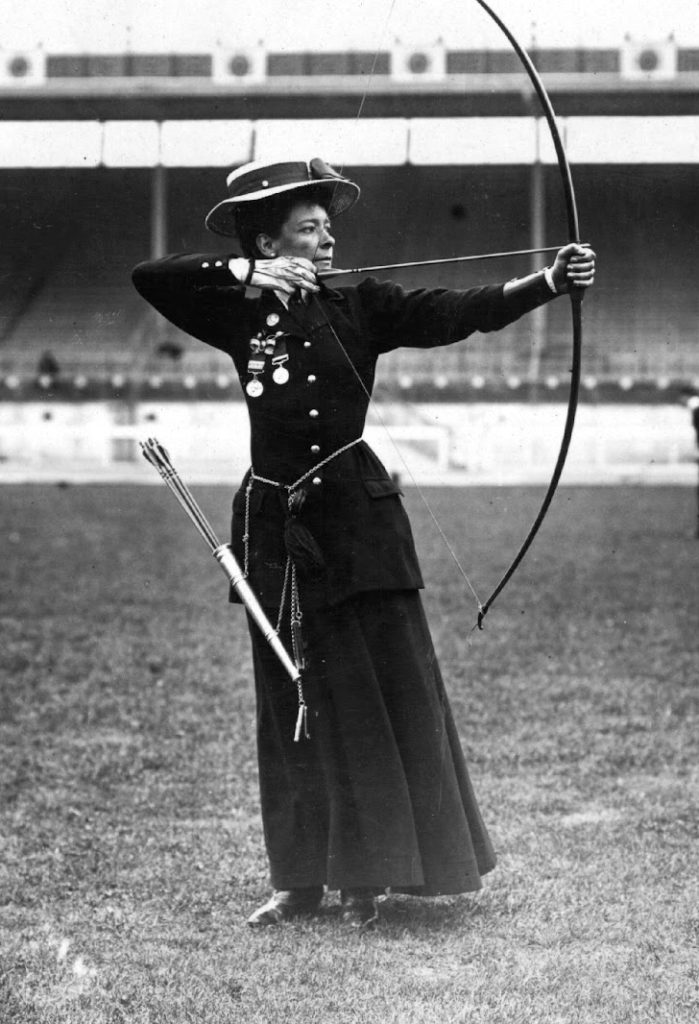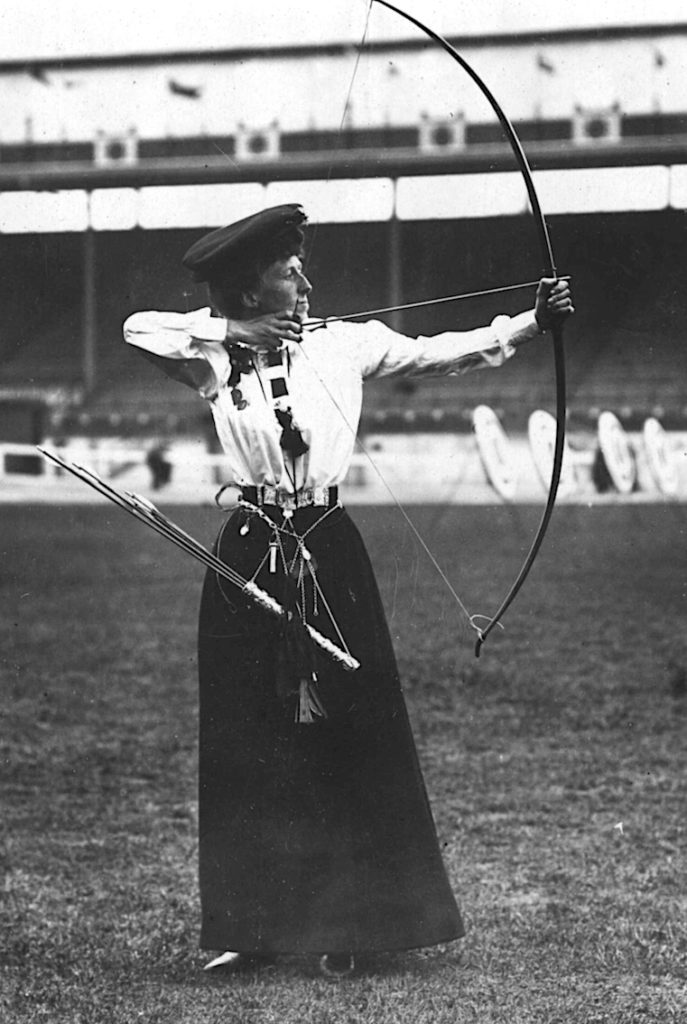Jan H Sachers takes an in-depth look at the history of archery at the modern Olympic Games.
The Olympic Games of antiquity were held every four years from at least 776 BC to AD 393, when these ‘vulgar’ pagan displays were supposedly abolished by the Christian emperor Theodosius I. They encompassed various contests of running, lifting, throwing, jumping, fighting and, in later years, riding, as well as musical and poetic competitions and religious ceremonies.
The idea of the sporting contests was to find the perfect athlete, the fastest, strongest, most skilled hero, who excelled in many of these disciplines. Archery was never part of the Games since the ancient Greeks had a distaste for the bow, which could kill a man from afar instead of face to face.
The revival of the Olympic Games in modern times is essentially the life’s work of one man, the French educationalist Pierre de Frédy, Baron de Coubertin (1863-1937). He considered sports an ideal way to improve
and perfect an individual’s body, mind and soul, as well as to further moral and social strengths.
After 16 years of campaigning, the first Olympic Games of the modern era were held in Athens in 1896 under the slogan ‘citius, altius, fortius’, meaning ‘faster, higher, stronger’, which is still the Olympic motto today.
1900
Archery was first included as one of an estimated 28 disciplines in the second modern Olympic Games in Paris, held over the course of 162 days as part of the 1900 World’s Fair. Before World War I, the Games were organised by national sports organisations of the host countries, not the International Olympic Committee. These organisations had more or less free rein concerning disciplines, rules, modes of competition and so on.
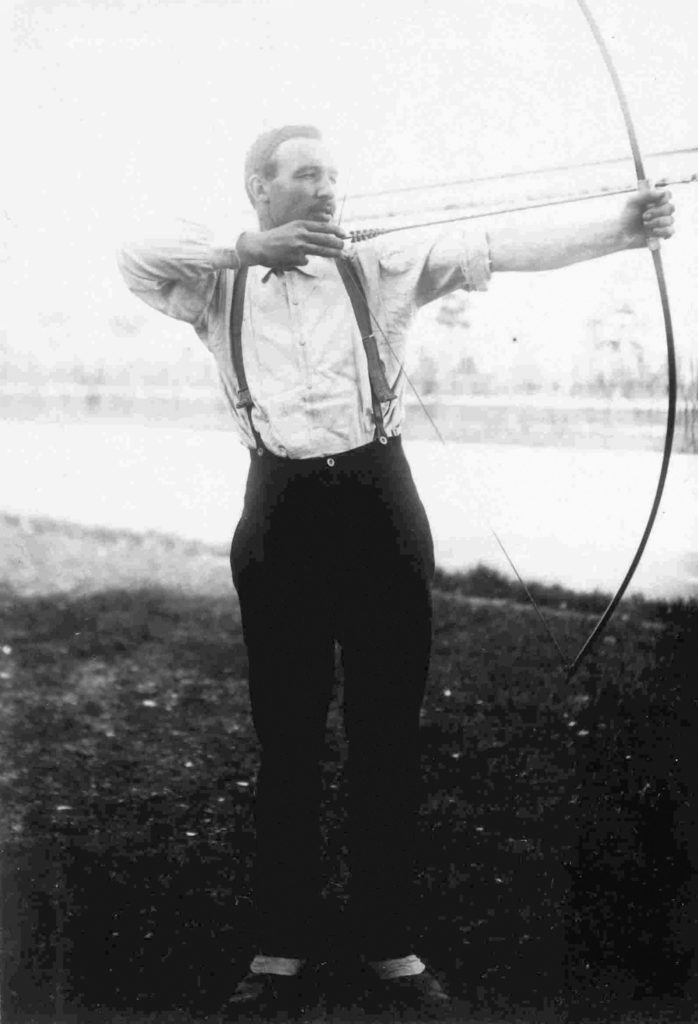
Unlike a few other sports, archery was still an exclusively male affair in 1900. Six different competitions were held, two of which were called Au Cordon Doré (at the golden string, or belt) and Au Chapelet (at the chaplet, or rosary). Each shot at 50m and 33m, for which the best six or eight archers had to qualify through large open team events.
Apparently, they were variations of the beursault, highly popular in France, where a target is set up at the end of a narrow path lined by hedges, trees or wooden boards. The cordon doré is the inner border of a beursault target, while the chapelet is the inner centre, inside a black circle. Unfortunately, no further records exist concerning the targets, scoring, number of arrows or pretty much anything else.
The remaining two competitions were Sur la Perche à la Herse (at the harrow on the pole) and Sur la Perche à la Pyramide (at the pyramid on the pole). Both were variations of ‘popinjay’, very popular in France and Belgium, with targets fixed on vertical poles 28m in height.
The ‘pyramid’ may refer to a set of rows above one another with a ‘cock’ on top, ‘hens’ below and ‘chicks’ at the bottom, but again, details appear to have been lost in time. A total of 129 archers competed in these perche events, at least six of them from the Netherlands, but the other nationalities are also unknown. Gold, silver and bronze medal winners in all six disciplines came from France or Belgium.
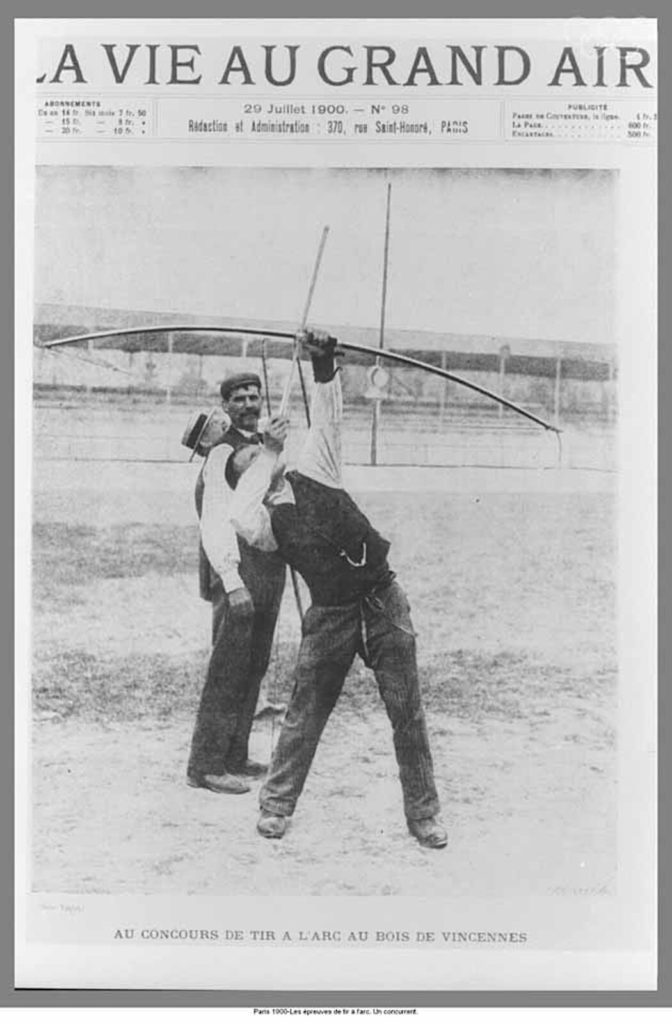
1904
The third Olympic Games, held in St Louis, Missouri in 1904, were the first ever held outside Europe. Of the 651 athletes who competed, only 62 came from outside North America, and only between 12 and 15 nations were represented in all. The exclusively American archery competitions for both men and women took place in a more conventional style than four years before.
The men shot a double American round with a total of 180 arrows at 60-, 50- and 40-yard distances, and a double York round of 72 arrows at 100 yards, 48 arrows at 80 yards and 24 arrows at 60 yards. The women shot a double Columbia round of 12 arrows at each of 50-, 40- and 30-yard distances, and a double National round of 24 arrows at 60 yards and 12 arrows at 50 yards. George Phillip Bryant, who competed for the first time, won both men’s competitions, and Matilda Scott Howell took gold in both women’s disciplines.
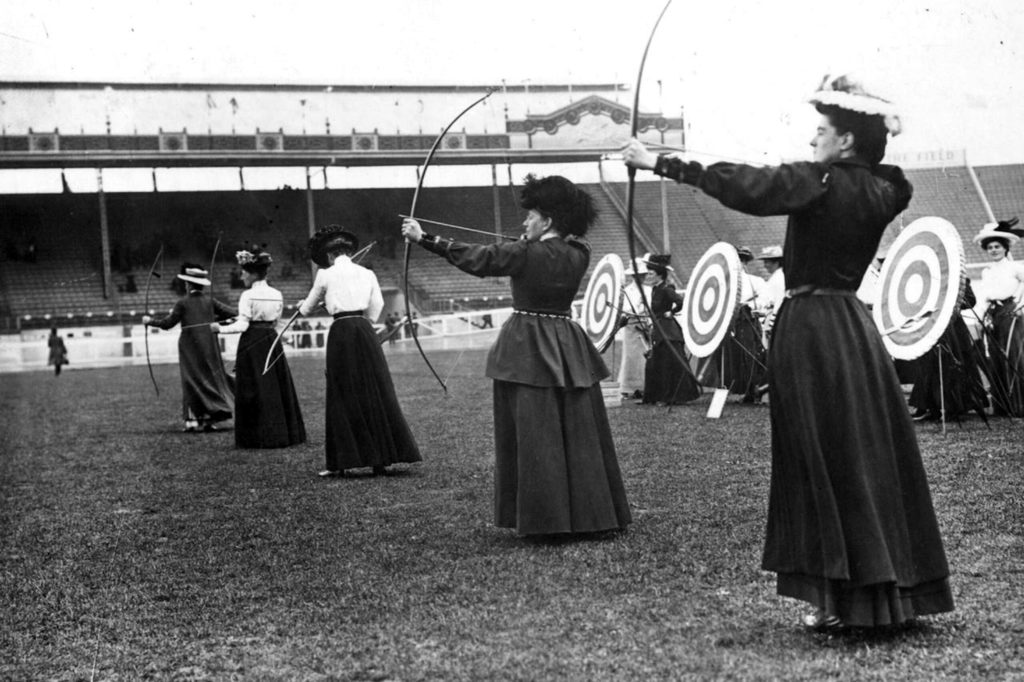
Her father, Thomas Foster Scott, came 17th in the double American round at the age of 71 years and 260 days, making him the oldest archer ever to compete in the Olympic Games. William Thompson, the famous American archer and co-founder of the American Archery Association, took home two bronze medals.
The events were held at Francis Field, Washington University, on 19-20 September in dismal conditions. “The targets were set in the Stadium, which had a floor of clay. Before the shooting began the rain fell for 15 hours, the clay held the water and the whole place became a sticky mud. Great balls of it clung to the archers’ feet as they sludged to and from the targets… standing on planks while they shot.” No doubt British competitors would have been familiar with such conditions.
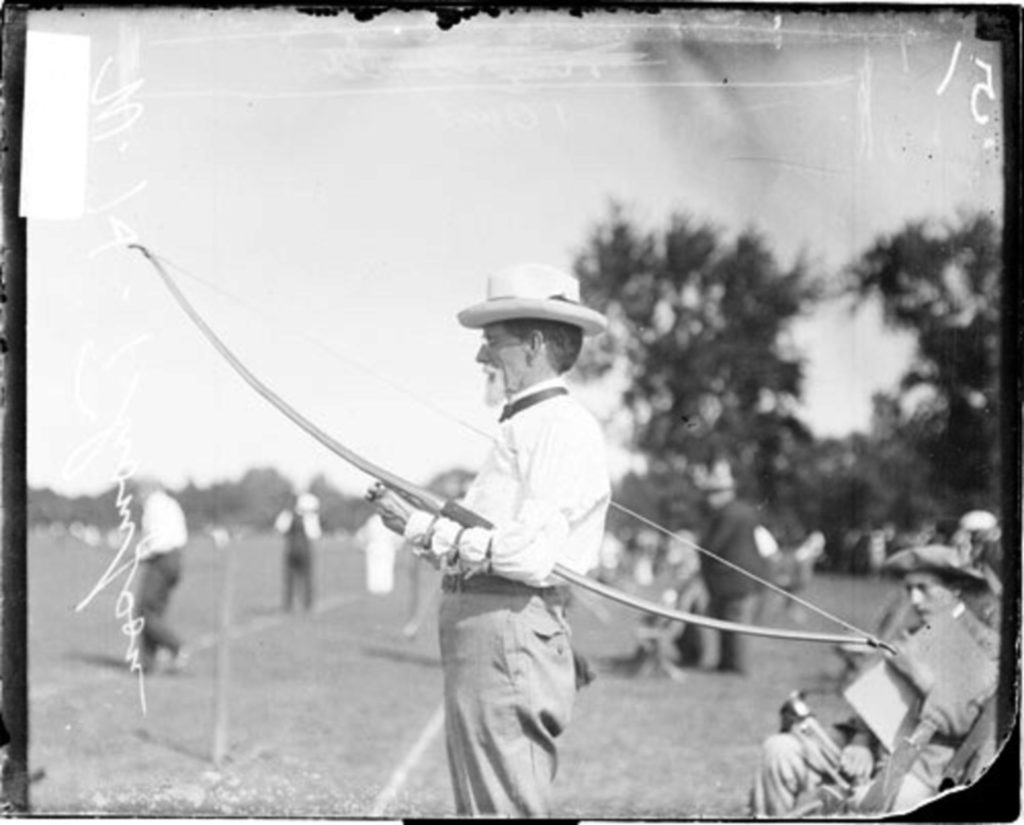
The 1904 Olympic Games were once again part of the World’s Fair, which also included a ‘human zoo’, euphemistically called ‘Anthropology Days’, where indigenous people from South-East Asia, the Pacific Islands, East Asia, Africa, the Middle East, South and North America were displayed in anthropological exhibits that showed them in their natural habitats.
Some of them also presented their native archery traditions. This sideshow, long unacceptable by modern standards, has been making Olympic historians uncomfortable ever since.
1908
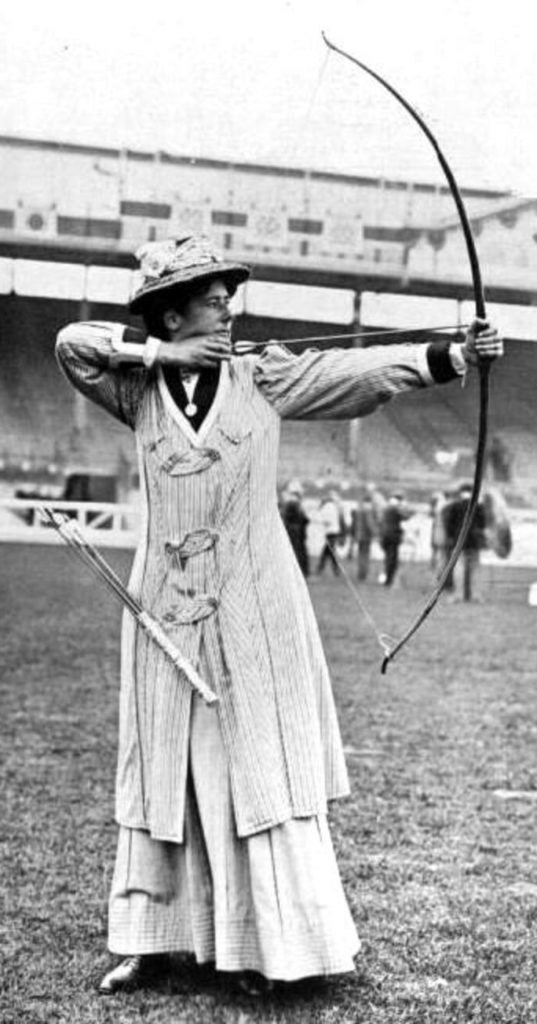
The Olympic Games of 1908 were to be held in Rome, but only 12 months before the event, the Italian Olympic Council announced that it was unable to fulfil its commitment due to the eruption of Vesuvius. Following an offer from the British Olympic Council, the meeting took place in London instead, over the course of 187 days.
The direction of each of the 22 sports was left to the management of their own governing body, so the Grand National Archery Society was approached to organise the archery events at the White City Stadium. The Royal Toxophilite Society appointed the necessary judges and officials and made the arrangements for three days’ shooting in the stadium at Shepherd’s Bush. Strict rules of competition included notes on general conduct and courtesy on the fields; for example, “Gentlemen will not be allowed to smoke at the ladies’ targets…”
The men – one from the US, 10 from France and 16 Britons – shot a double York round on 17-18 July in very English weather. William Dod won gold on his 41st birthday with a score of 815, 47 points ahead of silver-medal winner Reginald Brooks-King. Henry B Richardson, the only contestant from the US, came third with a margin of only eight points after he had begun the second day 50 points behind Brooks-King. Henri Berton, the best French archer, finished in 16th place.
While the British archers clearly dominated the York round, the French swept the continental-style event on 20 July. Forty arrows were shot at 50m, and of the 17 contestants, 15 came from France. Henry B Richardson, the lone American, finished 15th, while John Bunyan Keyworth from Great Britain came 12th. The winners were Eugène Grisot, Louis Vernet and Gustave Cabaret.
For the women, a double National round was held on 17-18 July, and all 25 competitors were British. At the age of 53 years and 275 days, Sybil ‘Queenie’ Fenton Newall won with a score of 688, making her the oldest Olympic gold medalist of all time. Great Britain did not win another women’s archery medal in the Olympics until 2004, when Alison Williamson took individual bronze.
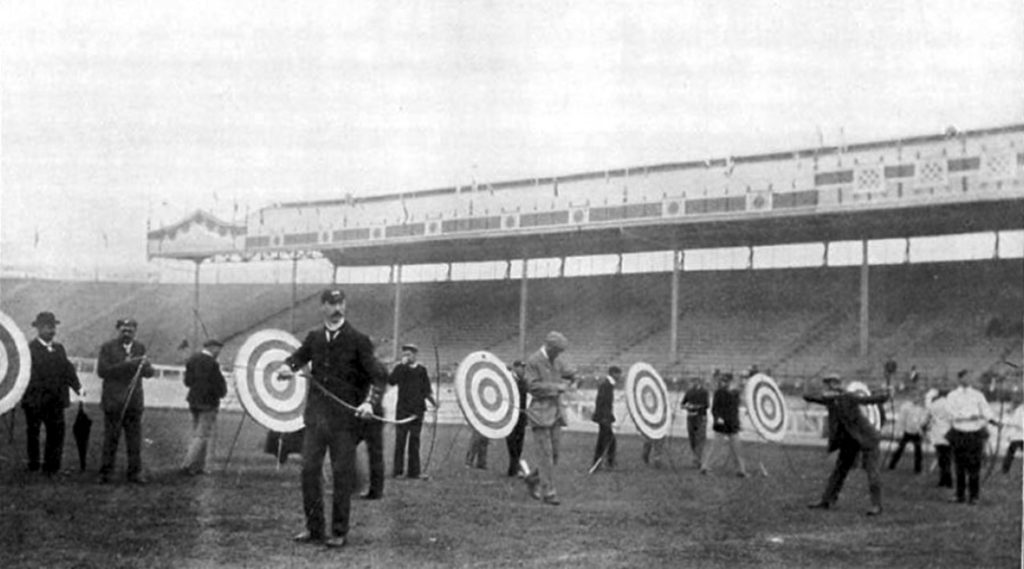
In second place was Charlotte ‘Lottie’ Dod, whose brother William had won the men’s York round. She was an extraordinary sporting multi-talent, best known for winning the Wimbledon ladies’ singles competition in tennis five times, first at the age of 15, making her the youngest champion ever.
Also a successful golf player, she co-founded one of the first women’s field hockey clubs in Britain. The Guinness Book of Records has named her the most versatile female athlete of all time. Beatrice Hill-Lowe, who finished third, became the first Irish woman to win an Olympic medal.
Archery was the only sport at the 1908 Olympics in which women could compete, since it didn’t involve any running and allowed for the participants to appear in ‘proper dress’. As was the custom in Great Britain at the time, both the men’s York and the women’s National rounds were shot both ways; in other words, in one direction first, then, after pulling the arrows from there, in the opposite direction at another row of targets.
1920
The 1912 Olympics in Stockholm did not include any archery, and in 1916 the Games were cancelled due to the outbreak of World War I. The Games of the VIIth Olympiad thus took place in Antwerp in 1920. Twenty nations competed in 29 disciplines, with Hungary, Germany, Austria, Bulgaria and the Ottoman Empire being banned from participation because of their role in the war.
Archery was part of the programme, but before the foundation of FITA (now World Archery) in 1931, no international rules existed, and the management of Olympic shoots was at the discretion of the host nation’s governing body. Traditions varied throughout Europe, and in Belgium as in the Netherlands and northern parts of France, popinjay or tir à la perche (shooting at the pole) was most popular.
Two such events were held, shooting at the large and the small bird. Six archers, all from Belgium, competed in each discipline, with individual scores being summed to give a team score. The top three scores for each team were used to determine placings, but only gold medals were awarded in the team events.
Additionally, a moving bird was shot at from 28m, 33m and 50m. Only two archers competed in each of these disciplines, with Julien Brulé from France winning over 50m and Hubert Van Innis coming second, but taking gold in the other two. Team medals were also awarded, but it is not clear how, and no records seem to exist detailing the sizes of targets, how many arrows were shot and so on.
Archery at Antwerp was an exclusively male event, with a total of 14 archers from Belgium and eight each from France and the Netherlands competing. Apart from finishing first in two of the moving-bird shoots, and second in the third one, Hubert Van Innis (aged 54) also won medals in the team events. Since he had already won gold in the Au Cordon Doré 33m and the Au Chapelet 33m, and silver in the Au Cordon Doré 50m in Paris 20 years earlier, he still holds the record as the most successful Olympic archer of all time, with a total of six gold and three silver medals.
Archery was not part of the Olympic Games between 1920 and 1972. When it was reintroduced in Munich 1972, the rules and modes of competition had finally been standardised. The tournament consisted of a double FITA round (known as a ‘1440 round’ since 2014) with two events, men’s individual and women’s individual.
This form of competition was kept until the 1988 Summer Olympics in Seoul when team competition was added, and the Grand FITA round format was used. Four years later, the Olympic round with head-to-head matches was adopted and has been in use ever since.
However, other changes have been even more dramatic and long-lasting than those of the rules. Longbows and wooden arrows are no longer used, having made way for modern recurve bows. Suits and ties for the men and long dresses for the women are no longer seen either, and while a general code of conduct still applies, it does not include any mention of gentlemen smoking at the ladies’ targets.


